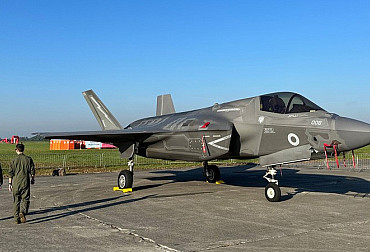Modern telecommunication networks as a strategic tool for defence: Implications for the Czech Republic and NATO
Revolutionary developments in telecommunications technology are dramatically reshaping the face of modern warfare and cyber defence. The implementation of 5G networks and research into emerging 6G technologies present an exciting opportunity for the Czech Republic and NATO allies to strengthen their defence capabilities, but at the same time they bring unprecedented security challenges. Strategic adaptation to these changes can be an important factor in maintaining competitiveness in 21st century military operations.

Technological context and strategic implications
The current transformation of telecommunications networks represents the most significant technological leap since the advent of the the Internet. While 5G networks offer transmission speeds of up to 20 Gbps, sub-1ms latency and support up to one million connected devices per square kilometre, emerging 6G technologies promise further orders of magnitude in performance. Expected parameters include data rates of up to 1 Tb/s, latency in the microsecond range and full integration with quantum communication systems.
For the Czech Armed Forces and NATO, these technological capabilities open up entirely new operational scenarios. The ability to transmit massive volumes of data in real time enables the creation of previously unfeasible ways of conducting combat operations, including:
- Comprehensive integration of unmanned systems with ground forces
- Use of augmented and virtual reality for tactical planning
- Deploying swarms of autonomous systems with collective intelligence
- Instantaneous processing of sensor data directly on the battlefield using powerful computers located as close as possible to the theater of combat operations, greatly accelerating command decisions
Transforming Military Operations in the Digital Era
The C4ISR Revolution
The implementation of 5G and preparation for 6G networks is fundamentally changing the face of Command, Control, Communications, Computing, Intelligence, Surveillance and Reconnaissance (C4ISR). The Czech Armed Forces are already implementing the first elements of this transformation:
1. Integrated Command Systems
- Development of advanced command centres with holistic situational awareness
- AI implementation for real-time decision support
- Creating mutually independent communication channels in the event of an outage or attack
2. Advanced sensor networks
- Deployment of distributed sensor arrays with autonomous data evaluation
- Integration of satellite, airborne and ground sensors into a unified system
- Rapid processing of combat data in theatre, without the need to send it to remote centres
3. Autonomous systems
- Development of coordinated swarms of reconnaissance drones
- AI implementation for autonomous logistics operations
- Testing unmanned combat systems with 5G connectivity support
Operational advantages and new possibilities
High-speed networks enable the Czech Armed Forces to:
- Precise coordination of multinational operations, including real-time sharing of tactical data between allied units, synchronization of joint operations with minimal latency, and effective integration of heterogeneous combat systems
- Advanced logistics support (automated tracking and management of supply; predictive maintenance of military equipment; optimization of resource utilization through AI)
Cybersecurity in the era of advanced networks
New threat categories
With the implementation of advanced telecommunications networks, sophisticated forms of cyber attacks are emerging:
1. Attacks on network infrastructure
- 5G Exploitation of vulnerabilities in 5G technology protocols
- Tampering with virtual parts of the network
- DDoS attacks (targeted overloading of the system with a mass of fake requests) on critical network components
- Attacking local computing units located in the field
2. Quantum threats
- Preparing for the era of quantum computers capable of breaking current encryption
- Need to implement post-quantum cryptography
- Protection against quantum sensor attacks
3. Hybrid warfare
- Combining cyber attacks with conventional military operations
- Disinformation campaigns using AI
- Manipulation of IoT devices in critical infrastructure
Cyber defence strategy
The Czech Republic and NATO are implementing a multi-layered approach to network protection:
1. Technological level
- Implementation of zero-trust architecture - "trust no one" system, every access must be authenticated
- Use of blockchain technology to secure communications
- Deployment of AI to detect and respond to threats
- Development of quantum-resistant encryption systems
2. Operational level
- Creating dedicated cyber units
- Regular testing of system resilience
- Continuous monitoring of network traffic
- Automated incident response.
3. Strategic level
- International cooperation in the field of cyber defence
- Sharing threat intelligence
- Joint development of defence technologies
- Harmonisation of legal frameworks for cyber operations
Challenges of implementation in the Czech Republic
Technological challenges
- The need to modernise existing infrastructure
- Ensuring compatibility with legacy systems
- Building redundant systems
- Implementation of advanced security mechanisms
Economic aspects
- High costs of implementing new technologies
- Need for continuous investment in research and development
- Reliance on foreign suppliers
- Necessity to build domestic capacity
Staffing
- Lack of qualified specialists
- Need for continuous staff training
- Adaptation of training programmes
- Development of specialised cyber units
Innovative approaches to safety
Technological innovations
1. Quantum Key Distribution (QKD) - "Unbreakable encryption based on quantum physics"
- Implementation of quantum key distribution
- Development of hybrid cryptographic systems
- Integration with existing infrastructure
2. AI-driven Security - "AI-driven system protection"
- Deploying AI for anomaly detection
- Automated response systems
- Predictive threat analysis
3. Network Slicing Security - "Securely slicing a network into independent virtual parts"
- Isolation of critical military systems
- Dynamic allocation of network resources
- Guaranteed QoS (Quality of Service) for priority communications
Organisational innovation
- Creation of dedicated cybersecurity teams
- Implementing agile methodologies for rapid adaptation
- Developing public-private collaboration
- International coordination of defence activities
Strategic outlook and recommendations
Short-term perspective (2024-2026)
- Complete the implementation of the core 5G infrastructure
- Upgrade existing command and control systems
- Establishment of a basic cyber defence framework
- Start training of specialised personnel
Medium-term perspective (2026-2028)
- Full integration of 5G network capabilities into military operations
- Implementation of advanced security mechanisms
- Development of autonomous combat systems
- Strengthening international cooperation in the field of cybersecurity
Long-term perspective (2028-2030+)
- Preparing for the implementation of 6G technologies
- Development of quantum-resistant communication systems
- Creation of a fully integrated cyber defence system
- Achieving technological sovereignty in key areas
Conclusion: building digital sovereignty in the context of collective defence
Successfully implementing advanced telecommunications networks represents a strategic opportunity for the Czech Republic to strengthen its position within the Alliance and enhance its own defence capability. The key to success is a balanced approach combining:
- Systematic building of technological capabilities
- Continuous development of human resources
- Deepening international cooperation
- Investing in research and development
Only a comprehensive approach encompassing all these aspects can ensure that the potential of 5G and 6G networks is effectively exploited while maintaining a high level of cyber security. The Czech Republic has a unique opportunity to become a significant contributor to NATO's technological modernisation and thus strengthen its role within the Alliance and, with it, on the geopolitical field.





















